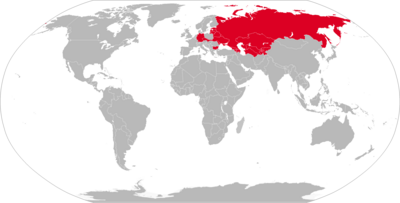OTR-23 Oka
| OTR-23 Oka SS-23 Spider | |
|---|---|
DSMAC active radar | |
| Accuracy | 30–150 m CEP |
Launch platform | Mobile TEL |
The OTR-23 Oka (
The main components of the 9K714 system were:
- the transport and launch vehicle PU 9P71 (Russian: cамоходная пусковая установка), based on the amphibious BAZ-6944
- the similar transporter-loader TZM 9T230 (Russian: транспортно-заряжающая машина) with one spare missile and equipped with a hydraulic crane
- the re-supply vehicle TM 9T240 (Russian: транспортная машина), a ZIL-131 tractor with semi-trailer to transport a missile (in transport container 9Ya249) and a warhead (in a 9Ya251 container)
The operational life of the Oka was limited and controversial. The Soviet military asserted that the Oka had a maximum range of 250 miles (400 km). American experts, however, estimated it had a greater range. In 1987,
There was diplomatic controversy over this weapons system in April 1990, when the Soviets informed the US of their covert transfer of at least 120 missiles to the Warsaw Pact states of Czechoslovakia, Bulgaria, and East Germany during the time of negotiation of the Intermediate-Range Nuclear Forces Treaty. Evidence indicates that the missiles were transferred with conventional warheads only, although equipment to load Soviet nuclear warheads was apparently retained.[3]
Missile variants

- The 9M714B missile armed with the AA-60 (9N63) nuclear warhead and possessing a maximum range of 500 km
- The 9M714F missile armed with a FRAG-HE warhead weighing 450 kg and possessing a maximum range of 450 km
- The 9M714K missile armed with a submunitions warhead 9N74K weighing 715 kg and possessing a maximum range of 300 km
In addition to these warheads, the OTR-23 Oka was also reported to be able to deliver chemical munitions.
Operators

Former operators
 Bulgaria
Bulgaria- Phased out in 2002
 Czech Republic
Czech Republic- Phased out in the 1990s
 Czechoslovakia
Czechoslovakia- Passed on to successor states
 East Germany
East Germany- Phased out in the 1990s, shortly before the reunification with West-Germany
 Slovakia
Slovakia- Phased out in 2000
 Soviet Union
Soviet Union- Phased out as directed by the INF Treaty
See also
Notes
- ^ http://www.missilethreat.com/missilesoftheworld/id.142/missile_detail.asp Archived 2007-09-29 at the Wayback Machine MissileThreat: SS-23
- ^ David Hoffman, The Dead Hand: The Untold Story of the Cold War Arms Race and Its Dangerous Legacy (Random House, 2009), 283-284.
- ^ https://fas.org/nuke/guide/russia/theater/ss-23.htm SS-23 SPIDER - Russian / Soviet Nuclear Forces
